Papers by Javad Haddadnia
Modern Applied Science, 2016

The temperature of human body is indicative of critical medical information concerning the whole ... more The temperature of human body is indicative of critical medical information concerning the whole body.Abnormal rise in total and regional body temperature is a natural symptom in diagnosing many types of diseases. Thermal imaging (Thermography) utilizes infrared beams, which are fast, non-invasive, andnon-contact. Generally, the output images by this technique are flexible and useful to monitor thetemperature of the human body. The purpose of this study is to determine the diagnostic value of thebreast tissue diseases by the help of thermography.In this paper, we used the non-contact infrared camera INFREC R500 for evaluating the capabilities of thermography. This study was conducted on 60 patients suspected of breast tissue disease, which werereferred to Imam Khomeini Imaging Center. The overall information was obtained from multiplesources including a predefined medical questionnaire, the performed clinical examinations, diagnosticresults obtained from ultrasound images, clinical biopsies and thermography. All of these inputs wereanalyzed by the respective experts of breast cancer. Medical analysis indicated that the use of Thermography as well as the asymmetry technique is useful in identifying hypo echoic and cysticmasses. It should be noted that the patient should not suffer from breast discharge.The Accuracy of the asymmetry identification technique for identifying hypo echoic and cystic masses is91/89% and 92/30%.In the same manner, the accuracy of identifying the exact location is 61/53% and75%. This method is also effective in identifying heterogeneous, fibro-adenoma, and Intra-ductalmasses. But it is unable to identify Iso-echo and calcified mass.According to the results of the investigation, Thermography is useful in the initial screening andsupplementation of diagnostic procedures due to its safety (its non-ionizing radiation property whichacts as everyday immersed heat), low cost and the exact recognition of diseases of the breast tissue/
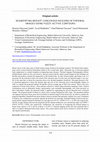
Breast cancer is the main cause of death among young women in developing countries. The human bod... more Breast cancer is the main cause of death among young women in developing countries. The human body temperature carries critical medical information related to the overall body status. Abnormal rise in total and regional body temperature is a natural symptom in diagnosing many diseases. Thermal imaging (Thermography) utilizes infrared beams which are fast, non-invasive, and non-contact and the output created images by this technique are flexible and useful to monitor the temperature of the human body. In some clinical studies and biopsy tests, it is necessary for the clinician to know the extent of the cancerous area. In such cases, the thermal image is very useful. In the same line, to detect the cancerous tissue core, thermal imaging is beneficial. This paper presents a fully automated approach to detect the thermal edge and core of the cancerous area in thermography images. In order to evaluate the proposed method, 60 patients with an average age of 44/9 were chosen. These cases were suspected of breast tissue disease. These patients referred to Tehran Imam Khomeini Imaging Center. Clinical examinations such as ultrasound, biopsy, questionnaire, and eventually thermography were done precisely on these individuals. Finally, the proposed model is applied for segmenting the proved abnormal area in thermal images. The proposed model is based on a fuzzy active contour designed by fuzzy logic. The presented method can segment cancerous tissue areas from its borders in thermal images of the breast area. In order to evaluate the proposed algorithm, Hausdorff and mean distance between manual and automatic method were used. Estimation of distance was conducted to accurately separate the thermal core and edge. Hausdorff distance between the proposed and the manual method for thermal core and edge was 0.4719 ± 0.4389, 0.3171 ± 0.1056 mm respectively, and the average distance between the proposed and the manual method for core and thermal edge was 0.0845 ± 0.0619, 0.0710 ± 0.0381 mm respectively. Furthermore, the sensitivity in recognizing the thermal pattern in breast tissue masses is 85 % and its accuracy is 91.98 %.A thermal imaging system has been proposed that is able to recognize abnormal breast tissue masses. This system utilizes fuzzy active contours to extract the abnormal regions automatically.
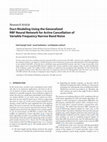
Eurasip Journal on Advances in Signal Processing, 2007
We have shown that duct modeling using the generalized RBF neural network (DM RBF), which has the... more We have shown that duct modeling using the generalized RBF neural network (DM RBF), which has the capability of modeling the nonlinear behavior, can suppress a variable-frequency narrow band noise of a duct more efficiently than an FX-LMS algorithm. In our method (DM RBF), at first the duct is identified using a generalized RBF network, after that N stage of time delay of the input signal to the N generalized RBF network is applied, then a linear combiner at their outputs makes an online identification of the nonlinear system. The weights of linear combiner are updated by the normalized LMS algorithm. We have showed that the proposed method is more than three times faster in comparison with the FX-LMS algorithm with 30% lower error. Also the DM RBF method will converge in changing the input frequency, while it makes the FX-LMS cause divergence.
Neural Network (HNFNN) human face recognition system. The face image is projected in each appropr... more Neural Network (HNFNN) human face recognition system. The face image is projected in each appropriately selected transform methods in parallel. The output of the RBF classifiers are fused together to make a decision. Experimental results for human face recognition confirm that the proposed method lends itself to higher classification accuracy relative to existing techniques.

Proceedings of the 10th Wseas International Conference on Signal Processing Computational Geometry and Artificial Vision, Aug 20, 2010
In this paper a fuzzy neural network is applied for real time traffic signal control at an isolat... more In this paper a fuzzy neural network is applied for real time traffic signal control at an isolated intersection. The FNN has advantages of both fuzzy expert system (fuzzy reasoning) and artificial neural network (self-study). A traffic light controller based on fuzzy neural network can be used for optimum control of fluctuating traffic volumes such as oversaturated or unusual load condition. The objective is to improve the vehicular throughput and minimize delays. The rules of fuzzy logic controller are formulated by following the same protocols that a human operator would use to control the time intervals of the traffic light. For adjusting the parameters of FNN, genetic algorithm was used. Compared with traditional control methods for traffic signal, the proposed FNN algorithm shows better performances and adaptability.
Pajoohandeh Journal, Dec 15, 2013
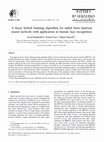
This paper presents a fuzzy hybrid learning algorithm (FHLA) for the radial basis function neural... more This paper presents a fuzzy hybrid learning algorithm (FHLA) for the radial basis function neural network (RBFNN). The method determines the number of hidden neurons in the RBFNN structure by using cluster validity indices with majority rule while the characteristics of the hidden neurons are initialized based on advanced fuzzy clustering. The FHLA combines the gradient method and the linear least-squared method for adjusting the RBF parameters and the neural network connection weights. The RBFNN with the proposed FHLA is used as a classiÿer in a face recognition system. The inputs to the RBFNN are the feature vectors obtained by combining shape information and principal component analysis. The designed RBFNN with the proposed FHLA, while providing a faster convergence in the training phase, requires a hidden layer with fewer neurons and less sensitivity to the training and testing patterns. The e ciency of the proposed method is demonstrated on the ORL and Yale face databases, and comparison with other algorithms indicates that the FHLA yields excellent recognition rate in human face recognition.
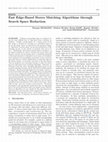
Ieice Transactions on Information and Systems, Nov 1, 2002
Finding corresponding edges is considered being the most difficult part of edge-based stereo matc... more Finding corresponding edges is considered being the most difficult part of edge-based stereo matching algorithms. Usually, correspondence for a feature point in the first image is obtained by searching in a predefined region of the second image, based on epipolar line and maximum disparity. Reduction of search region can increase performances of the matching process, in the context of execution time and accuracy. Traditionally, hierarchical multiresolution techniques, as the fastest methods are used to decrease the search space and therefore increase the processing speed. Considering maximum of directional derivative of disparity in real scenes, we formulated some relations between maximum search space in the second images with respect to relative displacement of connected edges (as the feature points), in successive scan lines of the first images. Then we proposed a new matching strategy to reduce the search space for edge-based stereo matching algorithms. Afterward, we developed some fast stereo matching algorithms based on the proposed matching strategy and the hierarchical multiresolution techniques. The proposed algorithms have two stages: feature extraction and feature matching. We applied these new algorithms on some stereo images and compared their results with those of some hierarchical multiresolution ones. The execution times of our proposed methods are decreased between 30% to 55%, in the feature matching stage. Moreover, the execution time of the overall algorithms (including the feature extraction and the feature matching) is decreased between 15% to 40% in real scenes. Meanwhile in some cases, the accuracy is increased too. Theoretical investigation and experimental results show that our algorithms have a very good performance with real complex scenes, therefore these new algorithms are very suitable for fast edge-based stereo applications in real scenes like robotic applications. key words: fast edge-based stereo, search spaces reduction, directional derivative of disparity, hierarchical multiresolution trical Engineering from Tehran Polytechnic University as the first rank in June 1973, and his M.S. and Ph.D. degrees in Javad Haddadnia received the BS.C degree in Electrical and Electronic Engineering with the first rank in 1993 and MS.c in Electronic Engineering in 1995, respectively, all from Amirkabir University of Technology, Tehran, Iran. He is now a Ph.D. candidate in the Electrical Engineering Department of Amirkabir University of Technology, Tehran, Iran. His research interests include digital image processing, computer vision and face detection and recognition. He has published many papers in the area of image processinhg. He served as a visiting research at the University of Windsor, Canada. He is a member of SPIE and CIPPR.
International Journal of Applied Pattern Recognition, 2015
Pattern Recognition, 2003
ABSTRACT

Proceedings of the 10th Wseas International Conference on Signal Processing Computational Geometry and Artificial Vision, Aug 20, 2010
Estimation and prediction are important tasks in the communication system. The LMS and RBF are su... more Estimation and prediction are important tasks in the communication system. The LMS and RBF are suitable algorithms for prediction of linear and nonlinear model respectively. The LMS (Least Mean Square) algorithm is a linear adaptive filter, which has properties of slow convergence and good tracking in low SNR and RBF (Radial Basis Function) adaptive filter is a nonlinear filter that predict nonlinear behavior of signals. The LMS algorithm can predict each part of signal which has linear form better than the RBF adaptive filter. However, if linear combining of buffered signal can predict subsequent sample, the RBF adaptive filter have not results as well as the LMS algorithm. Suitable soft or flexible switch is needed for this purpose. In this paper, a stochastic gradient based switch is proposed based on error of the LMS and RBF algorithms. The proposed algorithm is configured for prediction of sinusoidal signal and chirp tracking problem. Experimental results show better performance compared to both the RBF and LMS algorithms in prediction problem and noisy chirp tracking.

Journal of Biomedical Physics and Engineering, Aug 9, 2013
Breast cancer is currently one of the leading causes of death among women worldwide. The diagnosi... more Breast cancer is currently one of the leading causes of death among women worldwide. The diagnosis and separation of cancerous tumors in mammographic images require accuracy, experience and time, and it has always posed itself as a major challenge to the radiologists and physicians. This paper proposes a new algorithm which draws on discrete wavelet transform and adaptive K-means techniques to transmute the medical images implement the tumor estimation and detect breast cancer tumors in mammograms in early stages. It also allows the rapid processing of the input data. In the first step, after designing a filter, the discrete wavelet transform is applied to the input images and the approximate coefficients of scaling components are constructed. Then, the different parts of image are classified in continuous spectrum. In the next step, by using adaptive K-means algorithm for initializing and smart choice of clusters' number, the appropriate threshold is selected. Finally, the suspicious cancerous mass is separated by implementing the image processing techniques. We Received 120 mammographic images in LJPEG format, which had been scanned in Gray-Scale with 50 microns size, 3% noise and 20% INU from clinical data taken from two medical databases (mini-MIAS and DDSM). The proposed algorithm detected tumors at an acceptable level with an average accuracy of 92.32% and sensitivity of 90.24%. Also, the Kappa coefficient was approximately 0.85, which proved the suitable reliability of the system performance. The exact positioning of the cancerous tumors allows the radiologist to determine the stage of disease progression and suggest an appropriate treatment in accordance with the tumor growth. The low PPV and high NPV of the system is a warranty of the system and both clinical specialists and patients can trust its output.
This paper presents a high accuracy human face recognition system using multi-feature extractors ... more This paper presents a high accuracy human face recognition system using multi-feature extractors and multi-stages classifiers (MFMC), which are fused together through fuzzy integral. The classifiers used in this paper are Radial Basis Function (RBF) neural network while feature vectors are generated by applying PZM, PCA and DCT to the face images separately. Each of the feature vectors are sent
This paper presents a high accuracy human face recognition system using multi-feature extractors ... more This paper presents a high accuracy human face recognition system using multi-feature extractors and multi-stages classifiers (MFMC), which are fused together through fuzzy integral. The classifiers used in this paper are Radial Basis Function (RBF) neural network while feature vectors are generated by applying PZM, PCA and DCT to the face images separately. Each of the feature vectors are sent
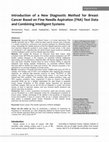
Iranian Journal of Cancer Prevention
Background Accurate Diagnosis of Breast Cancer is of prime importance. Fine Needle Aspiration tes... more Background Accurate Diagnosis of Breast Cancer is of prime importance. Fine Needle Aspiration test or "FNA”, which has been used for several years in Europe, is a simple, inexpensive, noninvasive and accurate technique for detecting breast cancer. Expending the suitable features of the Fine Needle Aspiration results is the most important diagnostic problem in early stages of breast cancer. In this study, we introduced a new algorithm that can detect breast cancer based on combining artificial intelligent system and Fine Needle Aspiration (FNA). Methods We studied the Features of Wisconsin Data Base Cancer which contained about 569 FNA test samples (212 patient samples (malignant) and 357 healthy samples (benign)). In this research, we combined Artificial Intelligence Approaches, such as Evolutionary Algorithm (EA) with Genetic Algorithm (GA), and also used Exact Classifier Systems (here by Fuzzy C-Means (FCM)) to separate malignant from benign samples. Furthermore, we examined ...
Proceedings of the 2002 International Joint Conference on Neural Networks. IJCNN'02 (Cat. No.02CH37290), 2002
Computer based face recognition system is still a challenging and difficult task. The difficultie... more Computer based face recognition system is still a challenging and difficult task. The difficulties arise due to large variations in facial appearance, head size, orien-tation and changes in environmental conditions. Such difficulties make face recognition one of the fundamental problems in ...










Uploads
Papers by Javad Haddadnia